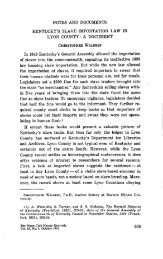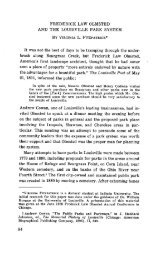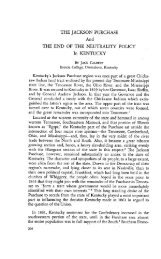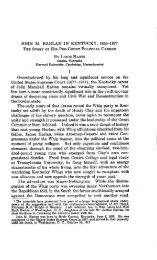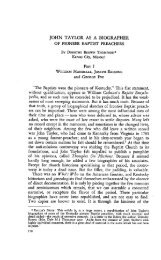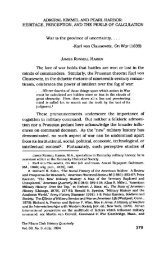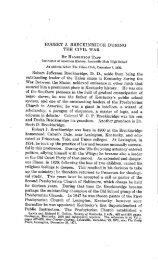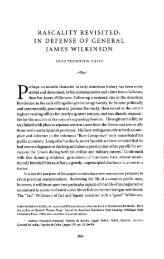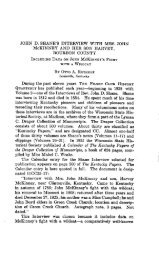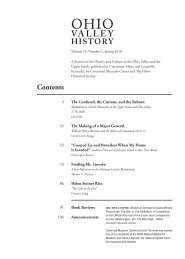Eskippakithiki, The Last Indian Town in Kentucky - The Filson ...
Eskippakithiki, The Last Indian Town in Kentucky - The Filson ...
Eskippakithiki, The Last Indian Town in Kentucky - The Filson ...
You also want an ePaper? Increase the reach of your titles
YUMPU automatically turns print PDFs into web optimized ePapers that Google loves.
Vol. 6 ] <strong>The</strong> <strong>Filson</strong> Club History Quarterly 357<br />
Tepee, Paducah, Omaha, Chatteroi, Kanawha, Missouri, Arkansas,<br />
Kansas, Iowa, Nebraska, and Dakota arc Siouan words.<br />
Among the Muskhogeans were the Chickasaws, Choctaws,<br />
Creeks, Sem<strong>in</strong>oles, Natchez, and Yemasees, who lived <strong>in</strong> the eastern<br />
Gulf States, <strong>in</strong> Tennessee, and <strong>in</strong> western <strong>Kentucky</strong>. <strong>The</strong>y<br />
<strong>in</strong>fluenced white settlement greatly and were a valiant, cultured,<br />
and able people. Many northern tribes fled to them for protection<br />
from the savage Iroquois, who never attacked them successfully.<br />
<strong>The</strong>y have given us many geographic terms, Appalachian,<br />
Caloosahatchie, Tuscaloosa, Tombigbee, Natchez, Yazoo, Alabama,<br />
and Oklahoma be<strong>in</strong>g some of them.<br />
THE SRAWNEES: Of all these ancient peoples, for purposes of<br />
this story, our greatest <strong>in</strong>terest is <strong>in</strong> the Shawnees who had, perhaps,<br />
the most eventful history of any tribe <strong>in</strong> the United States,<br />
a section of which, the Picts or Piquas, built the village of <strong>Eskippakithiki</strong><br />
<strong>in</strong> the southeastern corner of the present Clark County,<br />
<strong>Kentucky</strong>. Eskippaki is a Shawnee word mean<strong>in</strong>g "blue-lick," as<br />
a salt-sulphur spr<strong>in</strong>g was called; and (th)iki is a locative end<strong>in</strong>g<br />
which can be translated "place," the whole mean<strong>in</strong>g "blue-lickplace."<br />
<strong>The</strong> word Shawnee means "southerner" <strong>in</strong> the Algonquian<br />
tongues; and, historically, it became applied to those <strong>Indian</strong>s who,<br />
break<strong>in</strong>g away from the Outagami or Sauk Nation <strong>in</strong> Wiscons<strong>in</strong>,<br />
and mov<strong>in</strong>g southward across the Ohio, took the advance of the<br />
Algonquian <strong>in</strong>vasion <strong>in</strong> that direction, thereby acquir<strong>in</strong>g their<br />
new name. This southward movement of the Shawnees was the<br />
last part of a general movement of the Algonquians that began-accord<strong>in</strong>g<br />
to the ralam Olum, the birchbark historic record of the<br />
Delawares, a closely related Algonquian tribe--shortly before<br />
Leif Ericsson landed <strong>in</strong> V<strong>in</strong>land. Before that time all of the Algonquians<br />
seem to have lived north of the Great Lakes.<br />
When the Shawnees started south is not certa<strong>in</strong>ly known.<br />
However, it was not long before the French came to Ill<strong>in</strong>ois, for<br />
the Jesuit Relations of 1648 shows that some of them were with<br />
the Mascout<strong>in</strong>s <strong>in</strong> Ill<strong>in</strong>ois at that time; but before 1669 they had<br />
fled southward, try<strong>in</strong>g to escape the fierce war parties of the Five<br />
Nations. <strong>The</strong> Jesuit Relations of 1670 says that they then lived<br />
some distance to the southeast of Ill<strong>in</strong>ois, which puts them <strong>in</strong> Kentueky<br />
or Tennessee.



